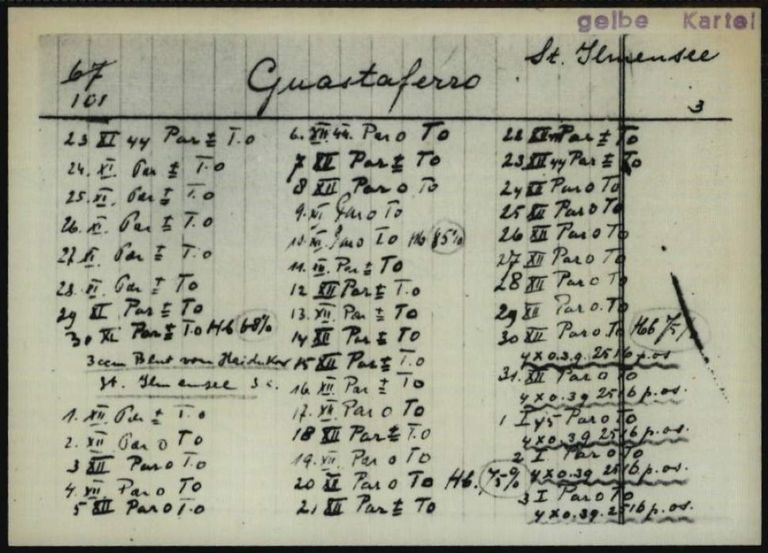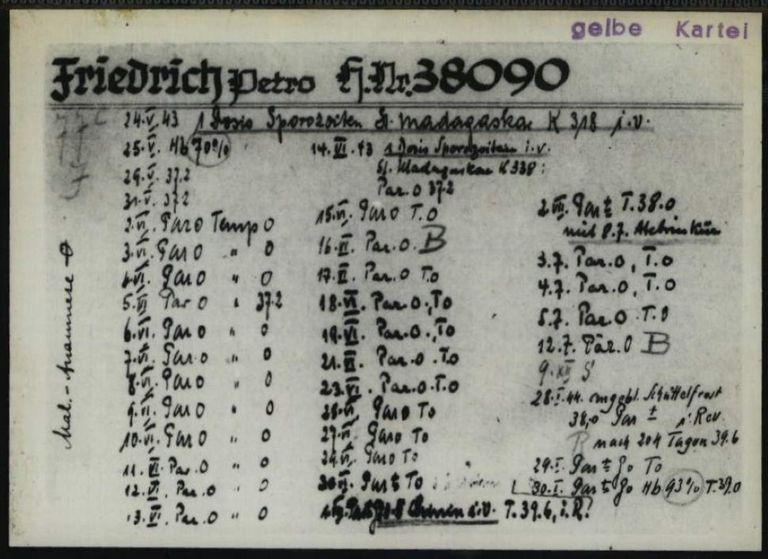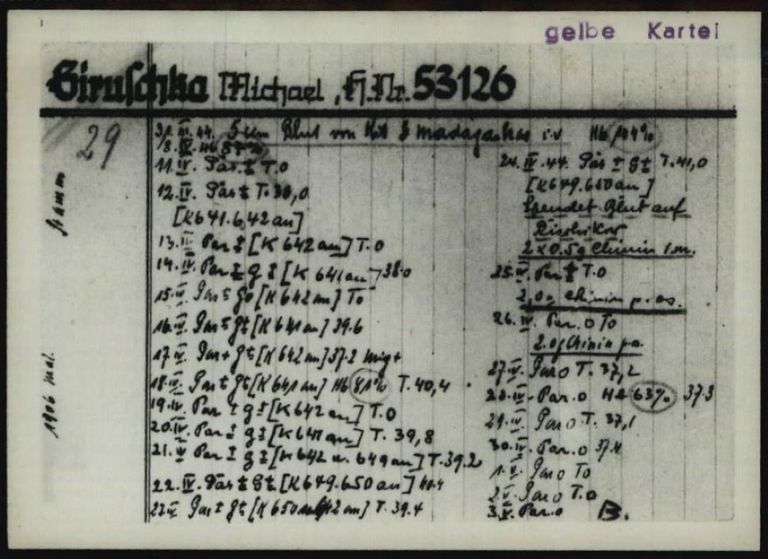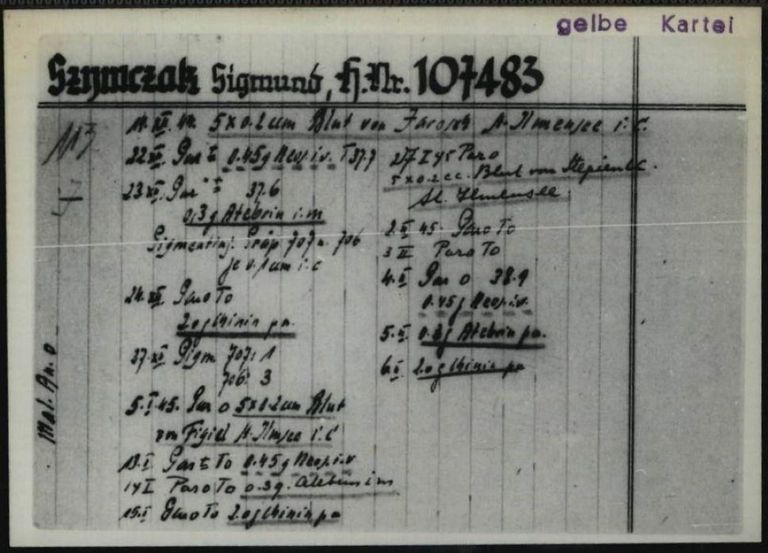Page of
Page/
- Reference
- Intro
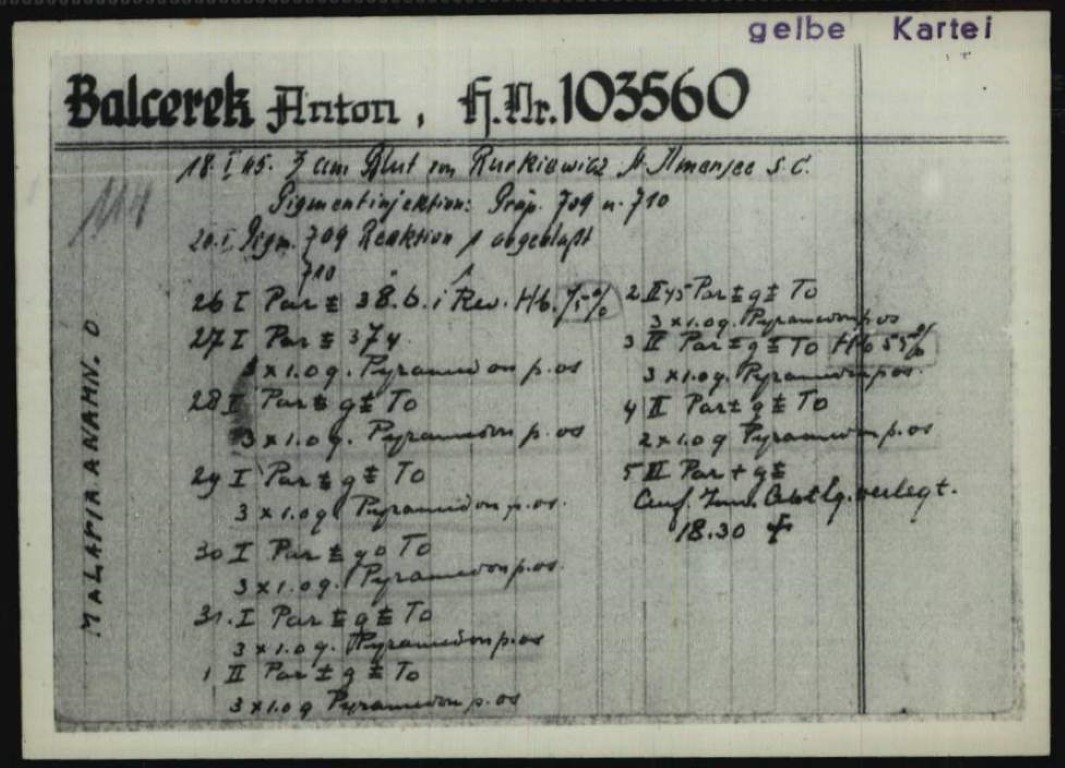

This is a card from what is known as the malaria card file. This file was created in Dachau concentration camp to record the human experiments in which prisoners were infected with malaria. The infection and course of the disease were noted in detail on these cards. Since a specific template had to be followed and a single prisoner clerk was responsible for the card file, the cards are all very similar.
This is a card from what is known as the malaria card file. This file was created in Dachau concentration camp to record the human experiments in which prisoners were infected with malaria. The infection and course of the disease were noted in detail on these cards. Since a specific template had to be followed and a single prisoner clerk was responsible for the card file, the cards are all very similar.
Questions and answers
-
Where was the document used and who created it?
From February 1942 to late March/early April 1945, the retired medical professor Claus Schilling conducted a series of experiments in Dachau concentration camp in an attempt to find an anti-malarial medication. Around 1,100 prisoners were infected with the disease for these experiments. First, prisoners from the penal detachment were selected for the experiments, then Polish clergy and later primarily Soviet and Italian prisoners. In the last months of the war, experiments were carried out on prisoners who were considered “unable to work” because they were ill or injured. At least 95 of them died, ten from the direct consequences of being infected with malaria.
For each test subject, a card was created in what was known as the Malaria Experiment Station (Malaria-Versuchs-Station or M.V.S., referred to from the end of 1942 as the Malaria Station). On this card the examination findings and administered drugs were recorded. The prisoner functionaries were given the names and prisoner numbers of the test subjects by the labor assignment department. In a letter to the ITS from 1968, Eugène Ost recalled that this information had been transferred to the cards in “Gothic script” by a Polish illustrator. Ost worked as a clerk at the malaria station from September 1942 to April 1945, and he entered all of the information on the cards during this period. This explains why nearly all of the cards are written in the same handwriting.
The malaria cards are simple file cards with a horizontal and a vertical line. They are not pre-printed cards like the sick bay cards. The narrow column on the card was not used as a separate space for information, however; most of the entries were written across this vertical line.
- When was the document used?
The malaria cards were used at the Malaria Experiment Station of Dachau from February 1942 until the experiments stopped on April 5, 1945. These cards were accompanied by temperature charts and treatment forms, though these were burned before the liberation to cover up the traces of the experiments. The cards from the malaria card file were also supposed to be destroyed, but prisoner clerk Eugène Ost managed to save some of the so-called yellow card file. The so-called red card file was found in the home of former prisoner August Vieweg while research was being conducted for the main Dachau trial in November 1945. Vieweg had been one of the first test subjects. He must have taken the red card file with him when he was ordered to destroy all evidence of the existence of the station in April 1945.
- What was the document used for?
The malaria cards were used to document the series of experiments. The goal of the experiments was to find a vaccine for malaria. To this end, prisoners were infected with tertian malaria pathogens, a form of malaria which is usually not fatal. The cards recorded when a prisoner was infected in which way, when the prisoner had a physical reaction, and whether any medications counteracted the symptoms. A Polish prisoner doctor took blood samples from the test subjects each morning and recorded the results in a notebook. Eugène Ost, the sick bay clerk, transferred this data to the treatment forms (also known as temperature charts) and then to the file cards. The results of the daily blood tests are always listed on the cards following the same pattern.
The gelbe Kartei (“yellow card file”) and rote Kartei(“red card file”) stamps in the upper right corner indicate the card file to which the respective card belonged. Two card files were kept in the Malaria Experiment Station, which was attached to the sick bay. The yellow card file was alphabetically ordered by the last names of the test subjects, while the red card file was ordered by test groups. The names of these card files refer to the fact that the original cards were written on yellow and red paper. These stamps are therefore not found on the original cards, only on the microfilm copies. Fundamentally, however, there are no differences between the cards from the two card files.
The malaria cards that can be accessed now at the Arolsen Archives were re-enlarged from the microfilms that were given to the ITS in the late 1960s. This is when the ITS began assembling collections of material on human experiments in various concentration camps on behalf of the International Committee of the Red Cross (ICRC). In 1960, the Federal Republic of Germany agreed to make compensation payments to former concentration camp prisoners from Eastern Europe who had been victims of human experiments. The ICRC coordinated these payments, and the ITS reviewed the more than 6,600 applications in advance by checking them against the existing documents. The ITS also carried out research in other archives and memorials and contacted former prisoners. For example, former prisoner clerk Eugène Ost was able to provide a good deal of information about the malaria file cards. It was also Ost who, in 1967, gave the original cards from the malaria card file to the archive of the Dachau Concentration Camp Memorial, where they are stored today.
- How common is the document?
The collection at the Arolsen Archives includes copies of around 600 cards for 310 individuals. Some of the file cards could not be saved in April 1945, which is why cards are not available for every single prisoner who was infected with malaria. Furthermore, multiple cards have been preserved for most of the test subjects, because experiments were carried out on them over a long period of time.
- What should be considered when working with the document?
The card file is evidence of the malaria experiments conducted in Dachau concentration camp. It is important to remember, however, that numerous human experiments were carried out in other concentration camps as well. It must be assumed that these experiments were also documented in those camps. However, the Arolsen Archives do not have as many of those documents as they do from the malaria card file.
If you have any additional information about this document or any other documents described in the e-Guide, we would appreciate it very much if you could send your feedback to eguide@arolsen-archives.org. The document descriptions are updated regularly – and the best way for us to do this is by incorporating the knowledge you share with us.
Help for documents
About the scan of this document <br> Markings on scan <br> Questions and answers about the document <br> More sample cards <br> Variants of the document
